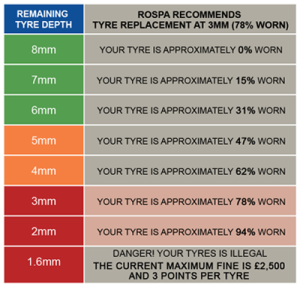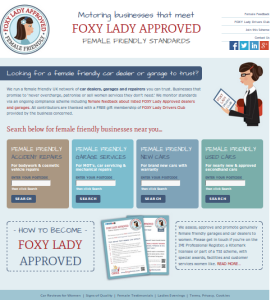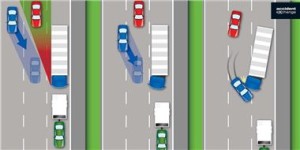During the recession we all scrimped where we could which was understandable. But there are some false economies relating to cutting back on car maintenance and other areas where you can probably save more money today, as follows.
1 Tyres

Common-sense tells us that tyre safety is critical.
We know that tyre tread levels should be a minimum of 1.6mm but did you know that at 3mm your tyres are approximately 78% worn?
This is when we recommend you go tyre shopping for as good a tyre deal as you can negotiate for the best tyre you can then afford.
When it comes to your personal safety and that of other motorists and pedestrians there are some economies that simply aren’t worth risking lives for.
To be precise:
+ Cheap tyres are likely to wear out quicker and can therefore be more expensive in the end than premium brands.
+ Never buy part worn tyres – you don’t know where they have been or why they are for sale.
+ Never fit different types or sizes of tyres on the same axle.
+ Use the tyres specified in the handbook for safe road grip, controlled steering, balanced suspension and ride quality.
Please see our new Female Friendly Tyre Services Register for details of businesses that have signed the FOXY Lady Promise to ‘never overcharge, patronise or sell women anything they don’t need.’
2 Car Servicing
 Some motorists seem able to ignore the depreciation of a new car (c60% of typical costs in 3 years) and not worry too much about car maintenance in those early years.
Some motorists seem able to ignore the depreciation of a new car (c60% of typical costs in 3 years) and not worry too much about car maintenance in those early years.
They prefer to rely on regular dealership servicing to keep their car street legal.
That’s their choice of course but, where you are cost conscious and footing the bill yourself, you can easily end up spending more on car servicing than you need to.
It’s important to relate all this to your annual mileage of course, and to understand why investing in regular car maintenance and car servicing WILL make sound financial sense in the end.
+ Unsurprisingly high mileage cars deserve a full service every year and providing they get this, high motorway mileage is kinder on engines than short local journeys when the engine rarely gets warm.
+ At the opposite end of the scale, assuming an annual mileage of c5000 miles or less, if you can keep a cherished family car running for longer this is definitely going to be your cheapest motoring choice, providing you change the engine oil and filters once a year as a minimum, interspersing an interim and full car service every other year.
3 Why clean oils matter
 Dirty oil and filters mean that bits of metal swarf/shavings will be circulating around your car engine, doing unforeseen and always expensive damage by wearing parts out so they need replacing sooner than they would do if lubricated by clean oils. Best to get into a habit of changing the oil regularly…
Dirty oil and filters mean that bits of metal swarf/shavings will be circulating around your car engine, doing unforeseen and always expensive damage by wearing parts out so they need replacing sooner than they would do if lubricated by clean oils. Best to get into a habit of changing the oil regularly…
Always use the oil that is recommended in your car’s handbook. When you know what your car needs, shop around to see where it’s cheapest. If you want a local garage to use your oil make sure you specify this ahead of the car service.
The FOXY jury is out when it comes to engine flushing oils. The likes of Forte Oils and garages that are members of the Good Garage Scheme will sell you these as an extra at each oil change. Some garages swear by them, claiming better engine performance, whereas other experts say that this can be particularly risky when it’s an old engine in case the actual ‘flushing’ process dislodges more than it was intended to. Few motorists realise they can say ‘no’ to recommended engine flushing oils here.
4 Choosing a franchised dealer or independent garage
 It used to be said that independent garages were the better servicing choice because they are likely to be cheaper than franchised dealers but that is rarely the full story.
It used to be said that independent garages were the better servicing choice because they are likely to be cheaper than franchised dealers but that is rarely the full story.
Our experience is that you should still shop around as some franchised dealers are extremely competitive in terms of attracting servicing business for older models and too many independent garages employ unlicensed mechanics to repair cars – you can check this at the IMI’s Professional Register.
To be precise…
+ New cars don’t have to be serviced by a franchised dealer during the manufacturer’s warranty period but it must always be serviced according to their recommended schedule and criteria, using only manufacturer approved parts. NB: Check insurance-backed extended warranties offered by dealers for different conditions.
+ If you get the car serviced by an independent you must make sure it’s done to the manufacturer’s recommended schedule and criteria using approved parts. You must also keep records so you can demonstrate to the manufacturer, if necessary, that servicing WAS undertaken to their requirements.
+ We recommend that manufacturer warranty work is undertaken by the nearest franchised dealer as it will be easier for them to deal directly with the manufacturer on your behalf.
Please see our new Female Friendly FOXY Lady Approved network of independent and franchised garages that have signed the FOXY Lady Promise to ‘never overcharge, patronise or sell women anything they don’t need.’ We look for measurable signs of quality before they sign up and we then measure their performance through a compliance process including regular feedback from women drivers including Club members.
5 Buying car insurance for women
We are determined to cut the cost of car insurance for women drivers at FOXY Lady Insurance by doing this within FOXY Lady Drivers Club. All you have to do is register for a quote now and we’ll contact you at renewal time to see if we can beat your best quote.
In this way we are reinstating the previous premium advantage most women drivers enjoyed on the basis of statistical evidence of their safer driving prior to the Gender Directive in 2012.
As a result of this ability to ring fence an insurance service for Club members who are also safer drivers we expect to reduce insurance premiums for an estimated 9 out of 10 female members based on the experience of our insurance broker, Cornmarket Insurance Services, gained whilst looking after the IAM scheme.
NB: Women who are not members of FOXY Lady Drivers Club will receive a special one-off gift membership (worth £20) when they buy FOXY Lady Insurance in 2015.
6 Miscellany
It makes sense to go along to a local ladies garage evening to find out what car maintenance you can do for yourself – this should include oil and water top up, tyre checks and lights as a minimum.
As sure as summer follows spring, expensive bills are likely to follow misfuelling (and driving afterwards, regardless), failing to replace a cambelt in time (always check this before buying a used car) and when your catalytic converter packs up. So keep your eyes open in these instances.
If you can get into the habit of checking your tyres regularly and looking out for any signs of punctures, rim/alloy or kerb damage you will be able to get your expensive tyres repaired and keep them going/safer for longer.
And when it comes to your air conditioning system, it’s best to have this serviced/re-gassed every 30,000 miles or so to ensure its efficiency when you need it most.
Sadly changing light bulbs can be expensive costing c£90 (mainly labour charges) on certain models where the individual motorist can’t do this for themselves. Ridiculous but true.
If you’d like help in any of these areas, it makes sense to join FOXY Lady Drivers Club for just £2 per month to have us handy when you need advice and support.
FOXY







 Many of us will travel to spend time with our families over the festive period.
Many of us will travel to spend time with our families over the festive period. 
